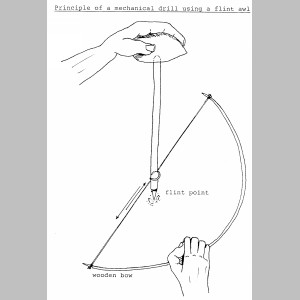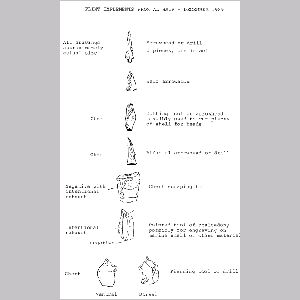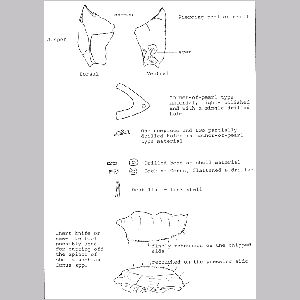Bulletin 41 - July 1990: Al Hair Archaeological Site
Al Hair Archaeological Site
By Pieter StoelBulletin No. 36 contains a short article on flint finds at Al Hair, north of Hili and just off the Al Ain-Dubai highway. I visited the site with Bish Brown in December 1989. All the surface material we collected had been uncovered by wind erosion and is slowly being recovered by shifting sands. Some Cyperus conglomerates and Hammada elegans shrubs were scattered in the vicinity. A long line of low rock formations some 20 m high stretch N-S nearby, parallel with the road. This limestone contains some Cretaceous fossils including gastropods, bivalves, sea urchins and the occasional Nautilus sp.
The site itself consists of two more or less oval shaped depressions of 10 m and 60 m long respectively. Ostrich shell, beads, seashell ornaments, one potsherd and hundreds of flakes of flint debris were scattered all over the place. The marine mollusks and flint I do not believe originated from this place, but may be from Oman, indicating a traveling route. One light colored piece of rock contained tiny veins of (presumably) copper ore, while another piece looked like jaspar. Among the chert a banded gray and white ore was found, and some artifacts could be identified. Because of the accompanying shell material, I believe some artefacts may have been used as tools on shell jewelry.
I also wondered whether the so-called arrowheads were in fact sophisticated drills. I took some to Holland to show a friend who happens to be a specialized flint expert. He couldn’t be sure either way as this UAE material was unfamiliar to him, but the principle of a mechanical drill made of flint is known from the literature. However, only relatively soft material such as amber, wood, perhaps pottery and soft stone could be drilled. As both hands are needed for the operation, it is unlikely that the small flat beads found were pierced with this type of drill. Perhaps a hand drill was used, as among the implements are two flint-piercing tools with intentionally retouched points. All in all, I feel that these objects are more likely to have been used as drills than as arrowheads. The objects are more triangular than is effective for arrowheads, which are more commonly flat on one side. In fact, evidence of such flat-sided points was found among the debris. Again, these implements are tiny, and if arrowheads could as easily have been made of hardened wood. (sic) The only other possibility other than a drill that I can see is that of a microfiche, a tool consisting of several tiny flint components commonly attached to a piece of wood or something similar.
As a drill, these triangular points would have had at least three advantages. First, they would be easy to attach to a piece of wood and hold firm. Second, a triangular shape can withstand relatively strong torsion forces. Third, the retouch has been made in such a way that the drill scrapes its way through the material. The drilled dust and scrapings may also be dispersed off in a way not dissimilar to our modern corkscrew tools.


